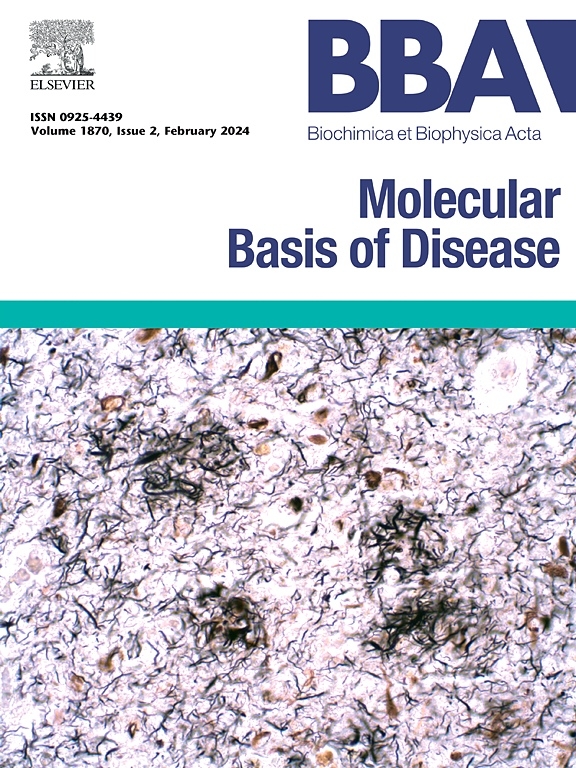番荔枝酸通过p53介导的卵巢癌DNA损伤的抗癌和化学增敏作用
IF 4.2
2区 生物学
Q2 BIOCHEMISTRY & MOLECULAR BIOLOGY
Biochimica et biophysica acta. Molecular basis of disease
Pub Date : 2025-07-04
DOI:10.1016/j.bbadis.2025.167971
引用次数: 0
摘要
卵巢癌(OC)是女性中一种高度致命的恶性肿瘤,通常在晚期被诊断出来。卡铂是临床使用的主要化疗药物;然而,大多数患者在初始治疗后出现复发和耐药性,迫切需要新的治疗策略。本研究探讨了三叶木犀草果实提取物中的活性物质甘油三酯的抗癌活性和化学增敏作用,并探讨了其在卵巢癌中的作用机制。结果表明,番荔枝酸显著抑制OC细胞活力、DNA复制和增殖,同时诱导细胞周期阻滞和衰老。此外,番荔枝酸降低OC细胞基质粘附,抑制细胞迁移和侵袭。此外,番荔枝酸通过诱导大量DNA损伤来增强卡铂的抗氧化作用,表现出协同抗癌作用。机制上,番荔枝酸通过p53信号通路介导的DNA损伤反应发挥了强大的抗癌和抗迁移活性。当与卡铂联合使用时,这种效果进一步增强。体内研究表明,番荔枝酸能有效抑制小鼠肿瘤生长,并与卡铂联用显示出优越的抑瘤能力。急性毒性试验证实,番荔枝酸在体内具有良好的生物安全性。综上所述,这些研究结果表明,茶花酸是一种很有前途的化疗药物,用于卵巢癌的治疗,并强调了其与卡铂联合使用的潜力,以改善卵巢癌的治疗结果。本文章由计算机程序翻译,如有差异,请以英文原文为准。
Anticancer and chemo-sensitizing effects of annonacin via p53-mediated DNA damage in ovarian cancer
Ovarian cancer (OC) is a highly lethal malignancy in women, often diagnosed at advanced stages. Carboplatin is the primary chemotherapy drug used clinically; however, most patients experience relapse and develop drug resistance after initial treatment, underscoring the urgent need for novel therapeutic strategies. This study investigated the anti-cancer activity and chemo-sensitizing effects of annonacin, an active compound in the fruit extract of Asimina triloba, as well as its underlying mechanisms in OC. Our results demonstrated that annonacin significantly inhibited OC cell viability, DNA replication, and proliferation, while inducing cell cycle arrest and senescence. Additionally, annonacin reduced OC cell-matrix adhesion and suppressed cell migration and invasion. Furthermore, annonacin enhanced the anti-OC efficacy of carboplatin by inducing substantial DNA damage, exhibiting a synergistic anticancer effect. Mechanistically, annonacin exerted potent anti-cancer and anti-migration activities through the p53 signaling pathway-mediated DNA damage response. When combined with carboplatin, this effect was further amplified. In vivo studies showed that annonacin effectively inhibited tumor growth in mice, and its combination with carboplatin demonstrated superior tumor-suppressive capabilities. Acute toxicity assays confirmed that annonacin possesses good biological safety in vivo. Collectively, these findings suggest that annonacin is a promising chemotherapeutic agent for OC treatment and highlight the potential of its combination with carboplatin to improve therapeutic outcomes in OC.
求助全文
通过发布文献求助,成功后即可免费获取论文全文。
去求助
来源期刊
CiteScore
12.30
自引率
0.00%
发文量
218
审稿时长
32 days
期刊介绍:
BBA Molecular Basis of Disease addresses the biochemistry and molecular genetics of disease processes and models of human disease. This journal covers aspects of aging, cancer, metabolic-, neurological-, and immunological-based disease. Manuscripts focused on using animal models to elucidate biochemical and mechanistic insight in each of these conditions, are particularly encouraged. Manuscripts should emphasize the underlying mechanisms of disease pathways and provide novel contributions to the understanding and/or treatment of these disorders. Highly descriptive and method development submissions may be declined without full review. The submission of uninvited reviews to BBA - Molecular Basis of Disease is strongly discouraged, and any such uninvited review should be accompanied by a coverletter outlining the compelling reasons why the review should be considered.

 求助内容:
求助内容: 应助结果提醒方式:
应助结果提醒方式:


